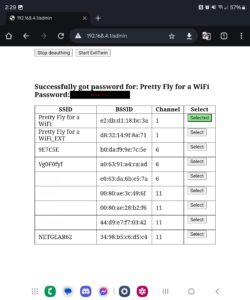In today’s hyper-connected world, our reliance on WiFi networks has never been more pronounced. From the comfort of our homes to the hustle and bustle of public spaces, we rely on WiFi connectivity to stay connected, access information, and enjoy a seamless online experience. However, with great convenience comes great risk. A vulnerable WiFi network can be a doorway to sensitive data, unauthorized access, and even physical harm.
In this article, we’ll explore the importance of WiFi penetration testing for individuals and businesses alike. We’ll discuss what WiFi penetration testing is, why it’s essential, and how you can perform your own tests using various tools and techniques.
What is WiFi Penetration Testing?

WiFi penetration testing involves simulating an attack on a WiFi network to identify vulnerabilities and weaknesses that could be exploited by hackers. The goal of penetration testing is not to cause harm or disrupt the network, but rather to identify areas for improvement and provide recommendations for remediation.
During a penetration test, a skilled tester will attempt to gain unauthorized access to your network, using various techniques such as password cracking, packet sniffing, and social engineering. The tester will then report on any vulnerabilities found, providing recommendations for patching or remediation.
Why Should You Perform WiFi Penetration Testing?

Performing regular WiFi penetration testing is essential for maintaining a secure wireless network. Here are just a few reasons why:
- Prevent Data Breaches : A vulnerable WiFi network can be a doorway to sensitive data, including financial information, personal identifiable details, and confidential business data. When a hacker gains access to your network, they may use malware or other tools to steal sensitive information or hold it for ransom. This can lead to identity theft, financial loss, and reputational damage. By identifying vulnerabilities in your WiFi network through penetration testing, you can prevent data breaches and protect your personal and business assets.
In addition to the risk of data breaches, a compromised WiFi network can also lead to other security incidents, such as unauthorized access to sensitive areas or systems. For example, if an attacker gains access to your home network, they may use it as a launching point for further attacks on other devices or networks. By performing regular penetration testing, you can identify and address vulnerabilities before they are exploited by attackers.

- Protect Your Home Network from Unauthorized Access : With the increasing number of connected devices in our homes, the risk of unauthorized access to your network is higher than ever. Smart home devices, IoT gadgets, and other connected devices can create new entry points for hackers, allowing them to gain access to your network and potentially steal sensitive information or take control of your devices.
Regular penetration testing can help you identify vulnerabilities in your WiFi network that could be exploited by attackers. By identifying these vulnerabilities, you can take steps to patch or remediate them, reducing the risk of unauthorized access to your home network.
In addition to protecting your home network from unauthorized access, regular penetration testing can also help you protect yourself and your family from potential harm. For example, if a hacker gains access to your home network, they may use it to launch attacks on other devices or networks, potentially putting your loved ones at risk.

- Improve Network Performance and Reduce Downtime : While security is the primary concern when it comes to WiFi penetration testing, there are also performance benefits to be gained from regular testing. By identifying and addressing vulnerabilities in your network, you can improve overall network performance, reducing the likelihood of downtime and improving user experience.
When a hacker gains access to your network, they may use malware or other tools to disrupt network traffic, causing slowdowns or even outages. In addition, if an attacker gains control of your devices or network, they may use them to launch DDoS attacks or other types of cyberattacks, further reducing network performance.
By performing regular penetration testing, you can identify and address vulnerabilities in your WiFi network before they are exploited by attackers. This can help improve overall network performance, reducing the likelihood of downtime and improving user experience.
How Can You Perform WiFi Penetration Testing?
To get started with WiFi penetration testing, you’ll need some specialized tools and knowledge. Here are a few resources to help you on your journey:

- For those looking to start small, consider using an ESP8266-based device, such as the NodeMCU Deauther (check out our article “ESP8266 Deauther – A Wild Ride Through WiFi Penetration Testing” for more information). This affordable and compact tool can help you identify vulnerabilities in your network.

- If you’re looking for something slightly more advanced, consider using an ESP8266-based Evil Twin device (our article “The Evil Twin Strikes Back: A Guide to Using the ESP8266 Evil Twin for Good (or Not-So-Good)” provides a comprehensive guide).
- For those with experience in WiFi hacking, the ESP32 Marauder is another powerful tool that can help you take your penetration testing skills to the next level (check out our article “Unleash The Beast: Mastering The Potential of the ESP32 Marauder“).
- Finally, if you’re looking for a more user-friendly approach, consider using Pwnagotchi, a plug-and-play device designed specifically for WiFi penetration testing (our article “Pwnagotchi: WiFi Pen Testing with a Nostalgic Twist” provides an in-depth review).
By following these resources and tips, you can start performing your own WiFi penetration testing and improving the security of your home network.
Conclusion
In conclusion, WiFi penetration testing is a critical aspect of maintaining a secure wireless network. By simulating an attack on your network, you can identify vulnerabilities and weaknesses that could be exploited by hackers. Regular penetration testing can help prevent data breaches, protect your home network from unauthorized access, and improve network performance.
Whether you’re an individual or a business, WiFi penetration testing is essential for maintaining the security and integrity of your wireless network. By performing regular tests and addressing vulnerabilities, you can reduce the risk of cyberattacks and enjoy a seamless online experience.







0 Comments